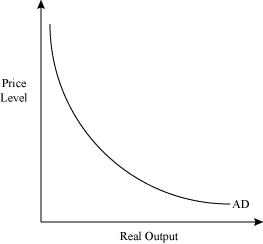Unit 3
Aggregate Demand Curve

- AD is the demand by consumers, businesses, government, and foreign countries.
What definitely doesn't shift the curve?
Changes in price level cause a move along the curve.
- Why is AD downward sloping?
- Real-Balance Effect
- Higher price levels reduce the purchasing power or money.
- This decreases the quantity of expenditures.
- Lower price levels increase purchasing power and increases expenditures.
- Ex: If the balance in your bank was $50,000, but inflation erodes your purchasing power, you will likely reduce your spending.
So... Price level goes up, GDP demand goes down.
- Interest-Rate Effect
- When the price level increases, lenders need to charge higher interest rates to get a REAL return on their loans.
- Higher interest rates discourage consumer spending and business investment. WHY?
- Ex: An increase in prices leads to an increase in the interest rate from 5% to 25%. You are less likely to take out loans to improve your business.
- Foreign Trade Effect
- When U.S. price level rises, foreign buyers purchase fever U.S. goods and Americans buy more foreign goods.
- Exports fall and imports rise causing real GDP demanded to fall. (Xn Decreases)
- Ex: If prices triple in the US, Canada will no longer buy US goods causing quantity demanded of US products to fall. Again, Price Level goes up, GDP demanded goes down (and Vice Versa)

No comments:
Post a Comment